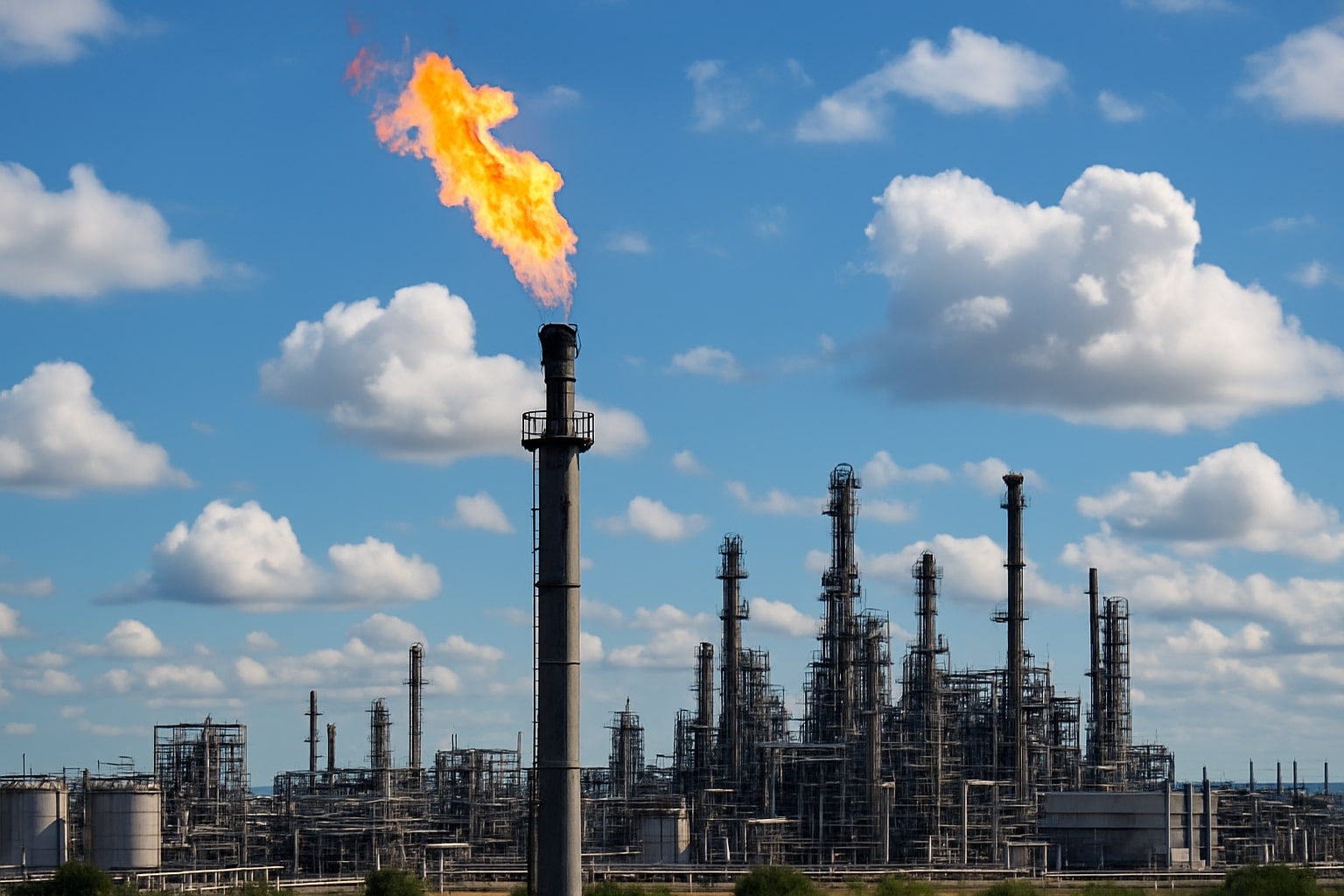
Natural Gas Price Forecast: NG=F Trades at $2.97 With U.S. Output Surge and $3.18 Resistance
Rising production, EIA storage builds, and Europe’s sanctions risk keep NG=F trapped below $3.18 while spot hubs diverge | That's TradingNEWS
Natural Gas Price Forecast: NG=F Struggles Near $3 as Production Surges and Weather Shifts
NG=F Holds $2.97 With Resistance at $3.06–$3.17
October natural gas futures (NG=F) traded at $2.97/MMBtu, holding inside an ascending channel that began in late August. The recovery was sparked after prices collapsed to a nine-month low in mid-summer, but upside momentum remains capped. Immediate resistance sits at $3.06–$3.17, where the 50-day moving average at $3.16 intersects with a long-term downtrend line. Tuesday’s bounce high at $3.07 failed to confirm a breakout. Support is layered at $2.94 and $2.85, with a deeper floor near $2.78 if sellers regain control. The RSI at 50 reflects balance, but the MACD flattening highlights that momentum has stalled.
EIA Storage and Inventories Add Pressure
The latest EIA storage report showed a build of +18 bcf for the week ending August 22, well below consensus at +27 bcf and the five-year average of +38 bcf. Even so, inventories remain 5% above the five-year seasonal norm and 3.5% lower year-on-year, showing the market is not in shortage. In Europe, storage levels sit at 78%, lagging the usual 85% at this point of the year. Traders remain cautious with the heating season weeks away, as supply overhangs could delay any bullish reversal.
Production Levels Remain Bearish
U.S. output continues to weigh on sentiment. The EIA raised its 2025 production outlook to 106.44 bcf/day, a +0.5% revision higher, with 2026 output forecasted at 106.09 bcf/day. Current lower-48 dry gas production runs at 107 bcf/day, up 4.8% year-over-year, near record highs. Rig counts confirm capacity expansion, with Baker Hughes reporting 122 active rigs, just shy of the two-year high at 124. This production surge keeps spot markets under pressure: Appalachian basin prices have collapsed below $1.50/MMBtu, halved since July, forcing producers to consider throttling output into fall.
Weather Shifts Cut Demand Expectations
Cooling demand is fading with forecasts showing below-average temperatures for the northern U.S. between September 7–16. Atmospheric G2 projects persistently cooler conditions in the East, trimming electricity demand from air conditioning. With U.S. power burn easing, consumption dropped to 71.2 bcf/day on September 2, only +1.2% y/y. LNG export flows remain steady at 15.2 bcf/day, a marginal +0.3% week-on-week, but not enough to offset weaker domestic demand.
Spot Price Volatility Across Hubs
Regional hub pricing reflects this imbalance. At Henry Hub, cash gas slipped –0.02 to $2.95/MMBtu, while SoCal Citygate traded at a premium near $3.55/MMBtu amid pipeline constraints. In the Northeast, Algonquin Citygate prices printed at $0.19/MMBtu, depressed by oversupply and seasonal weakness. Western hubs like Malin stood out, fetching $0.325/MMBtu, highlighting regional divergences. Appalachia averaged $0.15/MMBtu, underscoring the strain on local producers. These dislocations suggest uneven fundamentals across U.S. markets, with some regions struggling to clear excess output.
Geopolitical and Sanctions Risk for Europe
In Europe, futures climbed above €32/MWh as traders monitor potential new U.S. sanctions on Russia. Gazprom announced binding agreements for the “Power of Siberia 2” pipeline to China via Mongolia, expanding Moscow’s eastward pivot. With Russian flows uncertain, Europe remains reliant on LNG imports and storage reserves. Any U.S. move to curb Russian exports could cause rapid tightening, especially with inventories trailing their seasonal target. The risk premium has supported TTF prices despite muted demand, reflecting the geopolitical overlay on fundamentals.
Technical Structures Point to a Critical Test
Natural gas remains trapped between structural support and heavy resistance. The neckline of a head-and-shoulders pattern at $3.05 was tested but failed to break, reinforcing $3.18 as a decisive barrier. A sustained push above the 50-day would unlock upside toward the 200-day moving average at $3.50, a key pivot for bulls. On the downside, a drop through $2.85 reopens $2.62, the recent low that marked completion of a deep retracement within a descending channel. Traders view rallies into the $3.00–$3.10 zone as potential short entries until the broader downtrend is convincingly reversed.
Market Balance and Outlook
Electricity generation provided some cushion, with U.S. output for the week ending August 23 at 95,130 GWh, up 7.7% y/y. Over the last 52 weeks, generation rose 3.1%, keeping baseline gas demand intact. Still, the overall balance leans bearish with production outpacing incremental demand. Near-term trading is defined by whether NG=F can hold above $2.94 and overcome the $3.12–$3.19 band. Without a breakout, the market risks further downside into the mid-$2s.
That's TradingNEWS
Read More
-
SCHD ETF Price at $27: Can SCHD’s 4% Yield and 9.15% Dividend Growth Beat High-Yield Covered Call ETFs?
15.12.2025 · TradingNEWS ArchiveStocks
-
XRP ETFs Close on $1B Inflows as XRPI at $10.92 and XRPR at $15.52 Hit 52-Week Lows
15.12.2025 · TradingNEWS ArchiveCrypto
-
Natural Gas Price Forecast: NG=F Holds the $4 Floor as Oversupply Clashes with 2026 LNG Demand
15.12.2025 · TradingNEWS ArchiveCommodities
-
USD/JPY Price Forecast - Dollar to Yen At 155: Yen Strength Builds As BoJ Hike And NFP Collide
15.12.2025 · TradingNEWS ArchiveForex



















